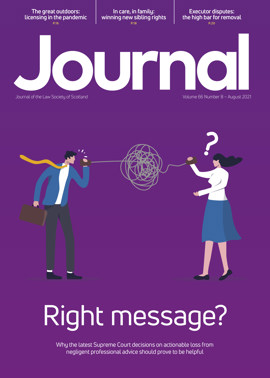In-house: Power of the nudge

Context is important in the choices we make in everyday life. If I had been asked last year whether I was in control of my own choices, I’d have answered with an emphatic yes. And yet, aged 17, I found myself signing up to be an organ donor when I’d gone online only to apply for my driving licence. Aged 23, I didn’t give much thought to my auto-enrolment into a firm pension scheme. Nowadays, I find myself adding extra treats to my basket while standing in the supermarket queue, saying yes to the Starbucks promotion, and never quite getting around to changing my energy provider (even if there are cheaper options out there).
Sound familiar? We probably all think that we are in control of our choices but, in reality, subtle influences (or nudges) impact our behaviour without us even realising it. Why is this? The science behind this is a discipline called behavioural economics which we’ve been leveraging in our team over the last year.
There are many situations in our day-to-day roles where we are looking to achieve a certain outcome – for example, making an improvement or change. For most of us in those situations, we rarely have the authority to require that others take action or buy into the change simply because we tell them to. Instead, it’s important for us to leverage our influencing skills and exercise soft power in order to nudge others towards our desired outcome.
Applying behavioural economics is a helpful discipline to continue building on these influencing skills and complement those behaviours. For example, in our team we have used behavioural economics to enhance the proposition that we offer to our stakeholders and make team processes even better.
What is behavioural economics?
The principles of economics assume we make decisions rationally in line with our longer term goals. If we were rational, we’d start saving early for retirement, eat healthily and arrive at work fully engaged and motivated. Behavioural economics on the other hand acknowledges that as humans we act instinctively, making many decisions out of habit or as a result of our cognitive biases.
Let’s take a look at some of the key biases and how we can easily leverage them in the legal profession.
Herding
What it is: we all have a natural desire to stay with the crowd and we don’t want to stand out. This means that our behaviour is heavily influenced by what we understand to be the norm. For example, HMRC found that the percentage of UK citizens paying their tax on time was increased substantially by the simple addition of “9 out of 10 taxpayers pay their tax on time” on the top of the letter requesting payment, with payment rates increasing further when this was tied to a local area or postcode. We don’t want to be an outlier, so we are more likely to follow the herd.
How we can leverage this: When influencing a colleague or client to make a desired decision, use your experience to your advantage by highlighting the norm. For example, “most stakeholders have taken the approach that…”. You can also effectively use this in negotiations to highlight the approach that you have seen agreed with other counterparties you’ve negotiated with. In our team we have used herding to encourage colleagues to do those admin tasks that fall down to-do lists by calling out a constituency who have completed them, tapping into the bias that we want to fit in with the crowd.
Anchoring
What it is: We have a bias towards being overly reliant on the first piece of information that we are given. For example, in the retailer TK Maxx, labels show the original retail price of the item above the TK Maxx price. We are more likely to buy the item against that backdrop because we feel like we are getting a bargain, versus the price alone in another shop without an anchor.
How we can leverage this: Anchoring is very powerful in negotiations, particularly in relation to liability caps. By suggesting a figure first to “anchor” the discussions, you can influence the counterparty to suggest a more palatable level of liability. Likewise, when advising stakeholders on proposed positions, switching up the order in which we give information provides an opportunity to influence. For example, instead of saying: “Party A has offered a liability cap of £500k but the organisation typically looks for liability caps of around £1 million”, try “Our expectation around liability as an organisation is £1 million minimum. Party A has only offered £500k here.” Anchoring the information this way will make the lower liability cap much less palatable.
Status quo bias/Default bias
What it is: This is the natural preference towards things staying the same. This is the reason I have failed to change my energy provider, as I’m more likely to accept the proposed renewal price than seek out a new provider. You will often see this leveraged by marketers who will try to tap into our bias by labelling the choice that they want you to make as the “most popular option” or auto-opting us in for the default. The UK Government’s policy around pension auto-enrolment is based around this preference for the default, and so too is the Scottish Government’s recent move to an opt-out system for organ donation.
How we can leverage this: When updating our template contracts, we leveraged default bias by pre-populating areas of our contract templates (such as interest rates and timeframes for notice periods) with suitable positions that worked for our organisation. Those we are negotiating with are less likely to amend these due to default bias than if we left unpopulated blanks. Likewise, in our team, when establishing changes to team processes, we’ve been keeping colleagues’ bias towards the status quo in the front of our minds. To counter this, we have been ensuring that we are highlighting the incentives from the outset to encourage a change.
Loss aversion
What it is: This is the tendency for us to feel more pain from losses than we do from equivalent gains. For example, imagine you found £20 in the street. You would feel happy for a few hours, imagining what you might spend it on. Contrast that with how you’d feel if you lost £20 – the pain of losing lingers far longer. The pain of losing out is almost twice the joy of gaining.
How we can leverage this: When providing legal advice, loss aversion can be used to encourage clients to make intelligent risk decisions by highlighting what they stand to lose if they take a particular course of action.
Retaining choice
It’s important to note that the examples above don’t remove the choice for the individual; rather they simply leverage natural biases to encourage a particular choice. Cass Sunstein, one of the leading professors on this topic, noted in his work that “putting healthy food at eye level counts as a nudge; banning junk food does not”.
Applying this to the legal profession
As legal advisers, we know that strong influencing skills are important to help us achieve good outcomes for clients and to build our relationships with them. The ability to add use of these “nudges” to this skillset and leverage behavioural economics can allow us to add another tool to our influencing toolbox, grow our personal influence in those relationships and help us drive the right outcome. Using subtle influencing cues can encourage stakeholders we work with to make desirable decisions around risk as well as allowing us to remove unnecessary friction. These little tweaks can make a big impact, and they don’t cost us a penny to apply. It’s a win-win.
If you’d be interested in learning more about how we’re applying this in our work at NatWest Group, please feel free to contact me at marliese.perks@natwest.com
Regulars
Features
Briefings
- Criminal court: Sentencing deconstructed
- Family: Litigation and lottery wins
- Human rights: Reinforcing the right to be forgotten
- Pensions: Plugging the LGPS exit credit hole
- Criminal law: The future of sexual offence trials
- Scottish Solicitors' Discipline Tribunal
- Property: Heat networks: the key to low-carbon heating?
- In-house: Power of the nudge






